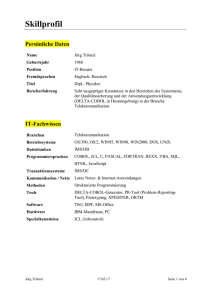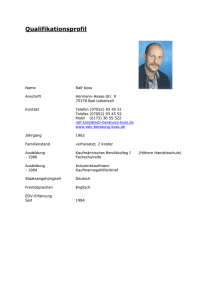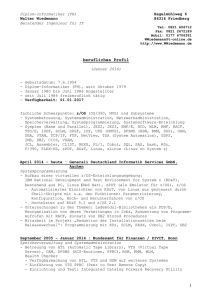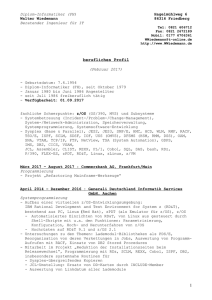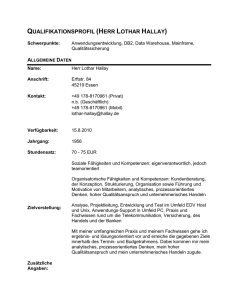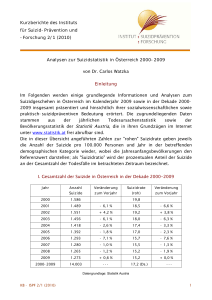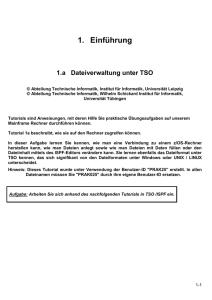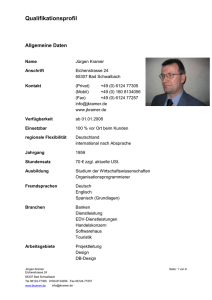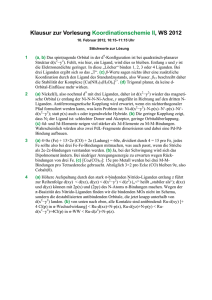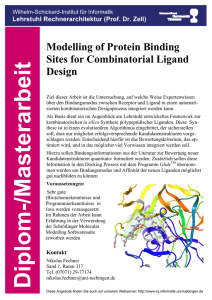Development of Inhibitors for the Enzyme IspF - ETH E
Werbung
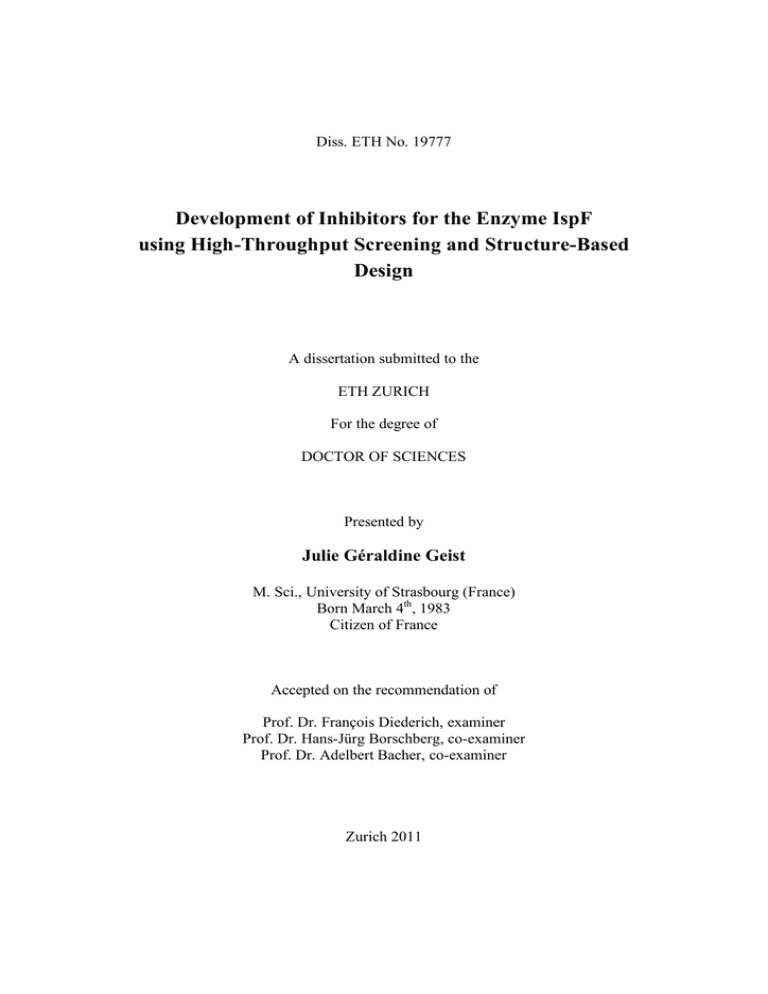
Diss. ETH No. 19777 Development of Inhibitors for the Enzyme IspF using High-Throughput Screening and Structure-Based Design A dissertation submitted to the ETH ZURICH For the degree of DOCTOR OF SCIENCES Presented by Julie Géraldine Geist M. Sci., University of Strasbourg (France) Born March 4th, 1983 Citizen of France Accepted on the recommendation of Prof. Dr. François Diederich, examiner Prof. Dr. Hans-Jürg Borschberg, co-examiner Prof. Dr. Adelbert Bacher, co-examiner Zurich 2011 Abstract Abstract Malaria is one of the most prevalent diseases, with approximately 300–500 million infections and 1–3 million deaths annually. A growing number of resistant Plasmodium strains against common antimalarial agents are observed, making the search for new drugs with novel mode of actions tremendously important. The discovery of the non-mevalonate pathway for the biosynthesis of the isoprenoid precursors isopentenyl diphosphate (IPP, 17) and dimethylallyl diphosphate (DMAPP, 18) in the early 1990s afforded new therapeutic targets for the development of new antimalarial drugs. Since this alternative pathway is present in pathogenic bacteria such as Mycobacterium tuberculosis as well as in protozoan pathogens such as Plasmodium falciparum, and is absent in humans, the enzymes of this pathway have been recognized as attractive drug targets. In this project, the fifth enzyme in the non-mevalonate pathway, IspF (EC 4.6.1.12), was chosen as target for the development of new inhibitors, using either high-throughput screening (HTS) or structure-based design. Many X-ray crystal structures of IspF are available in the Protein Data Bank (PDB), showing its quaternary structure as a homotrimer with three active sites, each located between two adjacent monomers. The active site of IspF is composed of two main pockets, pocket III, which is rigid and highly conserved, and pocket II, which is flexible and less conserved. In the beginning of the project, HTS enabled first the discovery of thiazolo[3,2-a]pyrimidines. Synthesis of a small library afforded ligands (±)-72–81, IC50 values [µM] IspF R1 (±)-72 (±)-73 (±)-74 (±)-75 (±)-76 (±)-77 (±)-78 (±)-79 (±)-80 (±)-81 2-benzofuranyl 2-thiophenyl 2-thiophenyl 2-thiophenyl 2-thiophenyl 2-thiophenyl 2-benzofuranyl 4-methoxyphenyl 2-thiophenyl Me P. falc. strains NF54 R2 R3 R5 Et Et Et Et Et Bn Et Et H H Br Br F H H Br Cl Br Br Br Br 32 ± 3 13 ± 2 3.9 9.6 ± 1.5 6.1 ± 0.8 1.5 Br F 89 ± 12 322 ± 42 n.d. Br 208 ± 22 125 ± 18 1.6 H > 300 > 300 3.2 Br 35 ± 5 2.1 ± 0.5 2.0 Cl 18 ± 2 7.4 ± 0.9 1.9 Br 11 ± 2 5.1 ± 0.4 1.5 Br 87 ± 7 141 ± 43 > 18 56 ± 5 65 ± 8 > 20 Br P. falc. M. tub. O R1 R2O O N N S R5 thiazolo[3,2-a]pyrimidines R3 OH which inhibited the IspF enzymes of Arabidopsis thaliana, P. falciparum, and M. tuberculosis in the low micromolar range. IX Best inhibitions were generally Abstract observed with R3 and R5 being bromine atoms, whereas the nature of substituent R1 was found to have little influence on the binding affinity of this class of compounds. The bis-sulfonamides were the second class of IspF inhibitors discovered by HTS. Ligands 88–109 were also found to inhibit the IspF enzymes of P. falciparum and A. thaliana in the very low micromolar range. Br For instance, ligands 102 and 107 showed IC50 values in the nM range against IspF of A. thaliana. R Inhibition data obtained with a coupled-enzyme R assay in the HTS were confirmed by a 13 C NMR assay, which proved that IspF was the actual target O O S NH NH A. thaliana IspF 102 R = NO2 IC50 = 690 nM 107 R = Br IC50 = 530 nM O S O Br for both compound classes. It was shown by isothermal titration calorimetry (ITC) that ligands bearing nitro groups or bromine atoms on their central core are able to complex the Zn2+ ion at pH 8, which may affect the catalytic activity of IspF in the biological assays. Unfortunately, no co-crystal of a protein-ligand complex could be obtained with both the thiazolo[3,2-a]pyrimidines and the bis-sulfonamides, making the identification of their binding mode in the enzyme difficult. In the P. falciparum cellbased assay, the thiazolo[3,2-a]pyrimidines showed activities in the low micromolar range against P. falciparum NF54 strains, whereas the bis-sulfonamides were inactive. Structure-based design was used to improve ligand affinity and solubility of cytosine analogues reported by C. Baumgartner, which afforded ligand 112 featuring a pyrrolidine ring to address pocket II. While solubility of this ligand in water was achieved, no activity against the target enzyme was observed. Next, cytidine-based 132–135 and substrate-based ligands 162 and 175, featuring an adamantyl or analogous subunit for the filling of pocket II, were synthesized but were also found to be inactive. Another challenge was to prevent binding of the substrate to the Zn2+ ion by developing small inhibitors bearing zinc-binding groups (ZBG). A fragment-based approach was used to design such small ligands, which enabled the discovery of the sulfonamide-based ligand 200 that showed activity in the millimolar range against IspF of E. coli. X Abstract CF3 N S H 2N 28% inhibition at 2 mM against E. coli IspF O O 200 In summary, it was shown in this project that inhibitors for the enzyme IspF could be either discovered by HTS with the challenge of identifying their binding mode, or by fragment-based design. It was observed that highly polar ligands do not inhibit the IspF enzyme, since high desolvation costs can reduce the overall gain in binding free energy. It is therefore necessary to find a compromise between ligand polarity and ligand affinity. Finally, the discovery of an adequate ligand that can address pocket II still needs to be identified. XI Zusammenfassung Zusammenfassung Malaria ist mit 300–500 Millionen Infektionen und ca. 1–3 Millionen Todesfällen pro Jahr eine der verheerendsten Tropenkrankheiten. Durch die stark wachsende Zahl von resistenten Plasmodium-Stämmen gegen bestehende Antimalaria-Wirkstoffe ist es für die Zukunft wichtig, neue Wirkstoffe mit einem neuartigen Wirkmechanismus zu finden. Die Entdeckung des mevalonatunabhängigen Biosynthesewegs der Isoprenoid-Vorläufer Isopentenylpyrophosphat (IPP, 17) und Dimethylallylpyrophosphat (DMAPP, 18) in den frühen 1990er Jahren erbrachte aussichtsreiche therapeutische Ziele für die Entwicklung neuer Wirkstoffe gegen Malaria. Da dieser alternative Weg bei Menschen nicht in Erscheinung tritt, sondern nur von Bakterien, wie den Tuberkulose-Erregern Mycobacterium tuberculosis, oder von Parasiten, wie den Malaria-Erregern Plasmodium falciparum, benutzt wird, wurden die Enzyme des mevalonatunabhängigen Weges als aussichtsreiche Ziele für die Entwicklung neue Wirkstoffe erkannt. In dieser Arbeit wurde das fünfte Enzym des mevalonatunabhängigen Weges, IspF (EC. 4.6.1.12), als Ziel für die Herstellung von Inhibitoren gewählt. Zwei verschiedene Methoden wurden dafür benutzt: High-throughput Screening (HTS) und Strukturbasiertes Design. Mehrere Röntgenkristallstrukturen von IspF sind in der Protein Data Bank (PDB) bekannt, die die quaternäre Struktur von IspF als Homotrimer mit drei aktiven Taschen zeigen. Eine aktive Tasche wird zwischen zwei Monomeren gebildet und besteht aus zwei Haupttaschen: “Pocket III”, die sehr konserviert und wenig flexibel ist, und “Pocket II”, die weniger konserviert und flexibler ist. Am Anfang dieses Projektes wurden mit Hilfe von HTS zuerst die Thiazolo[3,2-a]pyrimidine als potentielle Inhibitoren entdeckt. Die Herstellung von Derivaten führte zu den Verbindungen (±)-72–81, die das IspF–Enzym von Arabidopsis thaliana, P. falciparum und M. tuberculosis im niedrigen mikromolaren Bereich hemmen. Die besten Hemmwerte wurden mit Brom in den Positionen R3 und R5 gefunden. Der Substituent R1 scheint keinen Einfluss auf die Bindungstärke dieser Liganden zu haben. XII Zusammenfassung IC50–Werte [µM] IspF R1 (±)-72 (±)-73 (±)-74 (±)-75 (±)-76 (±)-77 (±)-78 (±)-79 (±)-80 (±)-81 2-Benzofuranyl 2-Thiophenyl 2-Thiophenyl 2-Thiophenyl 2-Thiophenyl 2-Thiophenyl 2-Benzofuranyl 4-Methoxyphenyl 2-Thiophenyl Me P. falc. Stämme NF54 R2 R3 R5 Et Et Et Et Et Bn Et Et H H Br Br F H H Br Cl Br Br Br Br 32 ± 3 13 ± 2 3.9 9.6 ± 1.5 6.1 ± 0.8 1.5 Br F 89 ± 12 322 ± 42 n.d. Br 208 ± 22 125 ± 18 1.6 H > 300 > 300 3.2 Br 35 ± 5 2.1 ± 0.5 2.0 Cl 18 ± 2 7.4 ± 0.9 1.9 Br 11 ± 2 5.1 ± 0.4 1.5 Br 87 ± 7 141 ± 43 > 18 56 ± 5 65 ± 8 > 20 Br M. tub. P. falc. O R1 R2O O N N S R5 Thiazolo[3,2-a]pyrimidine R3 OH Als nächstes wurden – ebenfalls durch HTS – die Bis-sulfonamide entdeckt. Die Verbindungen 88–109 hemmen das IspF Enzym von P. falciparum und A. thaliana im sehr niedrigen mikromolaren Bereich. Liganden 102 und 107 haben beispielweise IC50–Werte im nanomolaren Bereich gegen IspF von A. thaliana. Br Die gekoppelten R Enzymassay, der im HTS benutzt wurde, wurden R Hemmungsdaten nochmals mit einem aus 13 dem C NMR Assay überprüft, O O S NH NH A. thaliana IspF 102 R = NO2 IC50 = 690 nM 107 R = Br IC50 = 530 nM O S um zu bestätigen, dass IspF das richtige Target O Br für beide Verbindungsklassen ist. Es wurde mit isothermer Titrationskalorimetrie festgestellt, dass Liganden mit Nitro- oder Brom-Substituenten am mittleren Arylring das Zinkkation bei pH 8 binden und dadurch die katalytische Aktivität von IspF im Assay reduzieren könnten. Leider wurde mit beiden Verbindungsklassen kein Co-Kristall des EnzymLigand Komplexes erhalten, um den Bindungsmodus der verschiedenen Inhibitoren mit Hilfe der Röntgenstrukturanalyse zu identifizieren. In einem Cell-based Assay zeigten die Thiazolo[3,2-a]pyrimidine Aktivität im niedrigen mikromolaren Bereich gegen P. falciparum–NF54–Stämme, wohingegen die Bis-sulfonamide inaktiv waren. Strukturbasiertes Design wurde als zweite Methode benutzt, um die Wasserlöslichkeit und Affinität von früheren Cytosinanaloga, die von C. Baumgartner hergestellt worden sind, zu verbessern. Ligand 112 mit einem Pyrrolidinring, der die Pocket II ausfüllen soll, wurde als neues Analogon vorgeschlagen. Obwohl die Wasserlöslichkeit verbessert werden konnte, hat Ligand 112 keine Aktivität gegen IspF gezeigt. Ausserdem wurden die Cytidinderivate 132–135 und Substratderivate 162 und 175, die die Pocket II mit einen Adamantylrest oder ähnlichem ausfüllen, hergestellt, sie waren jedoch inaktiv gegen das Zielenzym. XIII Zusammenfassung Als nächstes wurde versucht, die Koordination des Substrates am Zn2+–Ion zu verhindern, durch die Herstellung von Liganden mit Resten, die typischerweise Zinkionen stark binden können. Durch Design von kleinen Fragmenten wurde Ligand 200 entdeckt, der Aktivität im millimolaren Bereich gegen IspF von E. coli zeigt. CF3 N S H 2N 28% Hemmung bei 2 mM gegen E. coli IspF O O 200 In dieser Arbeit wurde gezeigt, dass Inhibitoren für das Enzym IspF entweder durch HTS oder Design von kleinen Fragmenten entdeckt werden können. Es wurde festgestellt, dass sehr polare Verbindungen zu keiner Aktivität führen, weil zu viel Desolvatisierungsenergie gebraucht wird. Deswegen ist es wichtig, einen Kompromis zwischen Polarität und Affinität des Ligandes zu finden. Schliesslich muss immer noch ein passender Ligand gefunden werden, der mit Pocket II in Wechselwirkung tritt. XIV
